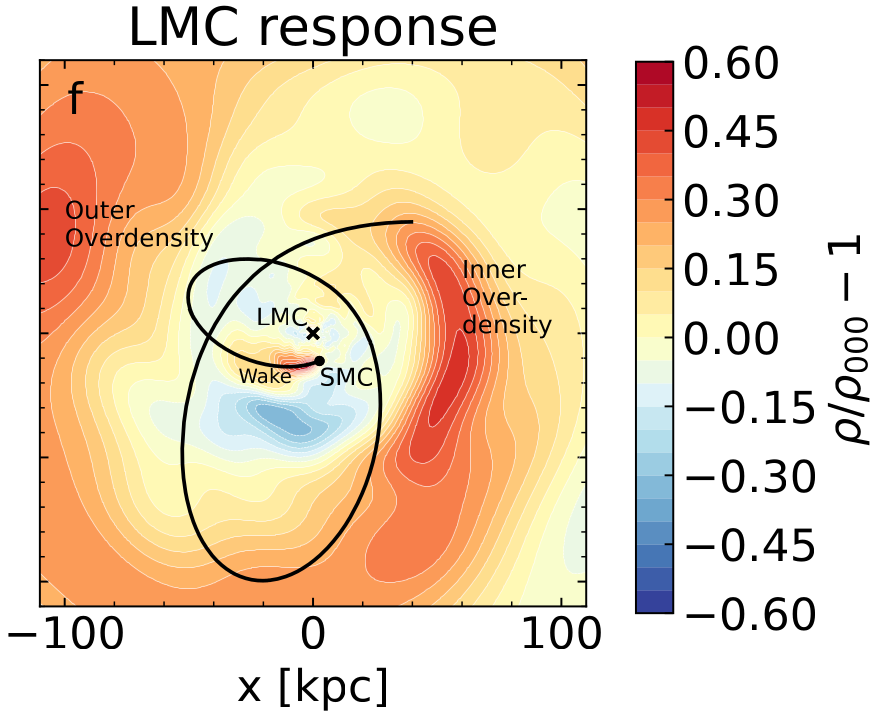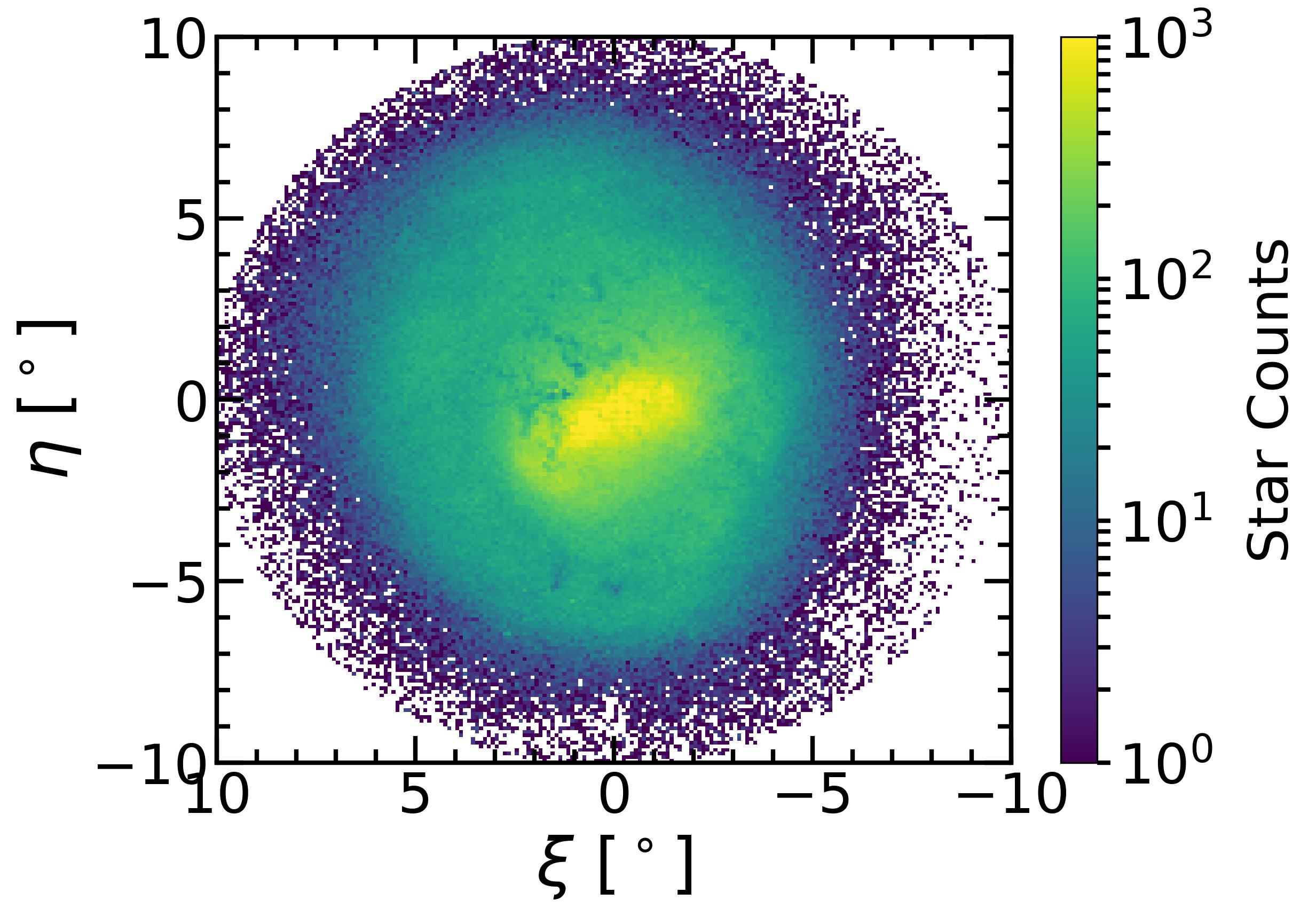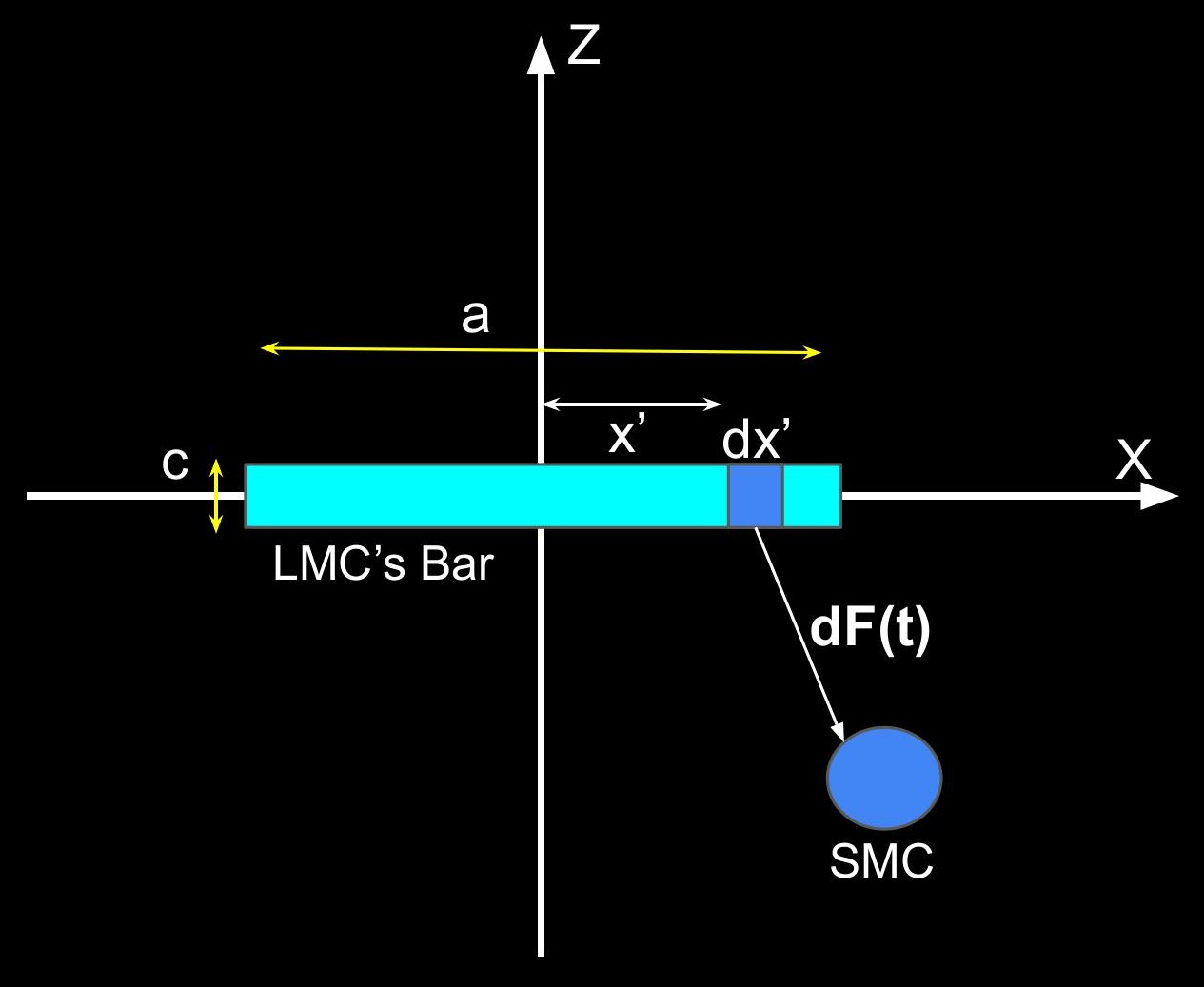Currently, I am investigating the LMC - SMC - Milky Way system. The LMC & SMC (collectively known as the Clouds) are the two most massive satellite galaxies of our Milky Way. The Clouds have been interacting with each other since the past 6 billion years ! Vast observations have enabled the utilization of the Clouds as an Astrophysical lab. I am using this lab to advance our understanding of galaxy dynamics, interstellar medium & dark matter physics, using a combination of observational datasets, numerical simulations & analytical theory. My research related to the Clouds is outlined below:
Distorted Dark Matter Halos of the Clouds

The LMC's distorted dark matter halo. Source: Foote, Rathore+2026(c)
The mutual LMC-SMC interactions have significantly distorted their dark matter distributions. Modeling their complex dark matter distribution is important for accurately inferring the LMC-SMC interaction history as well as the orbits of the satellite galaxies associated with the Clouds. In Foote,Rathore+2026, we use Basis Function Expansions to build a framework for mapping the dark matter halos of the LMC and SMC. We find that the SMC's dynamical friction wakes can distort the LMC's dark matter halo density field by as much as 60% relative to a spherical distribution. Further, the halo distortions in the LMC-SMC system can be generalized to other 1:10 mass ratio interacting galaxy pairs in the universe.
SMC - A Galaxy in Transformation

Our likely viewing perspective of the SMC.
Source: Rathore+2025(c)
Despite a wealth of observations, interpreting the SMC’s structure & kinematics has been a challenge. The SMC’s gas exhibits a substantial velocity gradient, yet the stars show minimal rotation. The SMC has an on-sky stellar extent of a few kpc, yet its line of sight depth is > 10 kpc, and the stellar and gas centers are separated by > 1 kpc. The SMC is clearly in a very high state of disequilibrium. Using hydrodynamic simulations, in Rathore+2025(c), we showed that the SMC’s disequilibrium can be attributed to a recent (< 200 Million years ago) direct collision between the SMC and LMC. Tidal forces and ram pressure exerted by the LMC transforms the SMC from a rotationally supported to a dispersion dominated galaxy.
The LMC's Disequilibrium Bar & The SMC's Dark Matter

The LMC's completeness corrected Gaia DR3 red clump disk.
Source: Rathore+2025(a).
The LMC has a strange bar. The bar is offset from the disk center, tilted with the disk plane and does not drive gas inflows. In Rathore+2025(a), we used Gaia DR3 data to measure the geometry and strength of the LMC's bar with the stellar density field. To perform this measurement, we developed a novel solution to tackle crowding induced incompleteness in Gaia datasets. Surprisingly, we found that the LMC hosts a strong bar, similar to other barred galaxies in the local universe.
I gave a talk primarily focussed on this work in July 2024 at the Indian Institute of Astrophysics, slides can be found here.

Schematic showing the SMC's torques on the LMC's bar.
Source: Rathore+2025(b).
Why does the LMC's bar show such strange properties despite being consistent with bar - galaxy co-evolution ?
Using hydrodynamic simulations of the LMC - SMC - Milky Way interaction history, in Rathore+2025(b) we showed that the LMC bar's strange properties are explainable with a recent (150 - 200 Million years ago) direct collision between the LMC & SMC. This collision also significantly slows down the LMC's bar, potentially explaining the low observed pattern speed values. Further, the LMC bar's tilt is a direct probe of the SMC's dark matter profile, and requires the SMC to be a dark matter dominated galaxy.
I gave a talk primarily focussed on this work in March 2025 at the Durham University (UK), slides can be found here.
In addition to the Milky Way's neighbourhood, I have also performed investigations of more distant galaxies as well as the large scale behaviour of the universe:
Star-forming S0 Galaxies

Subaru Hyper Suprime Camera images of some star-forming S0s.
Source: Rathore+2022.
S0 galaxies possess well defined disks, but lack spiral arms and are generally expected to be quenched. Hence, the existence of star-forming S0s poses a significant challenge to galaxy evolution theories. In Rathore+2022, we performed a detailed study of star-forming S0s with resolved spectroscopic observations from the SDSS-MaNGA survey combined with deep optical imaging. Surprisingly, star-forming S0 galaxies in the local universe possess centrally dominated star-formation, which is different from disk dominated star-formation in typical spiral galaxies. Moreover, the star-forming S0s were most likely quenched S0s in the past whose star-formation has been rejuvenated, possibly through mergers with smaller galaxies.
For a relatively non-technical summary of this research, please refer to our article on CosmicVarta. I also gave a talk on this work at IIT Indore in July 2023, slides can be found here.
G-transition & the Hubble Tension

Effect of a G transion on the Cepheid Period-Luminosity relation.
Source: Ruchika, Rathore+2024
The Hubble tension is a raging debate in cosmology about the current expansion rate of the universe, as quantified by the Hubble constant. Early universe probes like the Cosmic Microwave Background and late universe probes like the Cepheid-Supernova distance ladder give different values of the Hubble constant. One possible explaination for the Hubble tension could be physics beyond the framework of general relativity, like a time varying gravitational constant (G). In Ruchika, Rathore et al. 2024, we proposed a transition in the value of G at late times, and evaluated its affect on the distance ladder. Through a careful statistical analysis, we found that a 4% larger value of the G at lookback times > 70 Million years is preferred by local universe data. Such a G transition is within existing observational constraints and can resolve the Hubble tension.